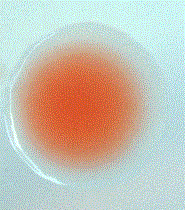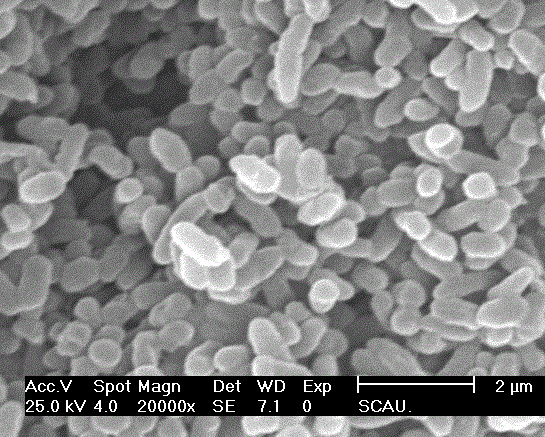A kind of Serratia marcescens ps-1 bacterial strain isolated from flea beetle and its application
A technology of Serratia marcescens, PS-1, applied in the directions of application, bacteria, microorganism-based methods, etc., can solve the problems of inconvenient pest control, inability to achieve both common pest control, etc., to ensure yield and quality, sustainable control effect
- Summary
- Abstract
- Description
- Claims
- Application Information
AI Technical Summary
Problems solved by technology
Method used
Image
Examples
Embodiment 1
[0038] The isolation culture method of embodiment 1 Serratia marcescens PS-1
[0039] 1. Isolation and re-infection of pathogenic bacteria
[0040] S1. Isolation of pathogenic bacteria
[0041] Take flea beetle larvae that were naturally infected with Serratia marcescens and died of red body color, and inoculated them into flat LB agar medium (agar 15-20g, sodium chloride 10g, tryptone 10g, yeast extract powder 5g , water 1L, pH 7.2), and cultured upside down in a 30°C incubator. After colonies formed, pick dark red colonies and separate them by plate streaking. Repeat 5 to 7 times to obtain a single colony, and then transfer to Put it on the LB agar medium on the slant of the test tube, and store it in the refrigerator at 4 °C.
[0042] S2. Re-infection of pathogenic bacteria
[0043] Inoculate the isolated single colony strain into a triangular flask filled with 100ml LB liquid medium (peptone 10g, yeast extract powder 5g, sodium chloride 10g, water 1L, pH7.2), and plac...
Embodiment 2
[0056] Example 2 The biological activity of Serratia marcescens PS-1 strain to flea beetle larvae
[0057] The flea beetle adults of the tested insect source were collected from the plant protection farm of the School of Resources and Environment, South China Agricultural University (the source of the tested insect is not limited to the present invention, and other sources of insect sources are also applicable to the present invention), and it was placed in the net room The planted cabbage seedlings were raised, and the eggs of the flea beetle were collected. After the larvae hatched, they were raised in petri dishes with radish slices until the third instar for testing.
[0058] Pathogen culture Pathogens were inoculated in 100 ml LB liquid medium, placed on a constant temperature shaker at 30°C, activated at 140 r / min for 10 hours, then transferred 1 ml of the bacterial liquid to 100 ml LB liquid medium, at 30°C, 140 r / min Cultivate for 24h. After centrifugation at 5000...
Embodiment 3
[0067] Example 3 Toxicity determination of Serratia marcescens PS-1 strain to flea beetle adults
[0068] The cultivation of Flea beetle and pathogenic bacteria for testing is the same as in Example 2.
[0069] Test method: Pick 1.5g of washed and dried Chinese cabbage leaves, 8 cfu ml -1 Soak in the bacterial suspension (containing 0.1% Tween-80) for 30 s, put it in a ventilated place to dry, put it in a petri dish, cover it with a plastic cover (9 cm in diameter, 21 cm in height), and insert it into yellow rice that has been starved for 2 hours. There were 10 flea beetle adults, and after 24 h, they were replaced with fresh cabbage leaves to continue feeding. The leaves of Chinese cabbage were treated with double distilled water containing 0.1% Tween-80 as the control group. Each treatment was repeated 5-7 times. Observed for 12 days, and recorded the number of dead adults every day. The test is carried out under the conditions of a temperature of 25±2°C, a relative hu...
PUM
 Login to View More
Login to View More Abstract
Description
Claims
Application Information
 Login to View More
Login to View More - R&D
- Intellectual Property
- Life Sciences
- Materials
- Tech Scout
- Unparalleled Data Quality
- Higher Quality Content
- 60% Fewer Hallucinations
Browse by: Latest US Patents, China's latest patents, Technical Efficacy Thesaurus, Application Domain, Technology Topic, Popular Technical Reports.
© 2025 PatSnap. All rights reserved.Legal|Privacy policy|Modern Slavery Act Transparency Statement|Sitemap|About US| Contact US: help@patsnap.com



